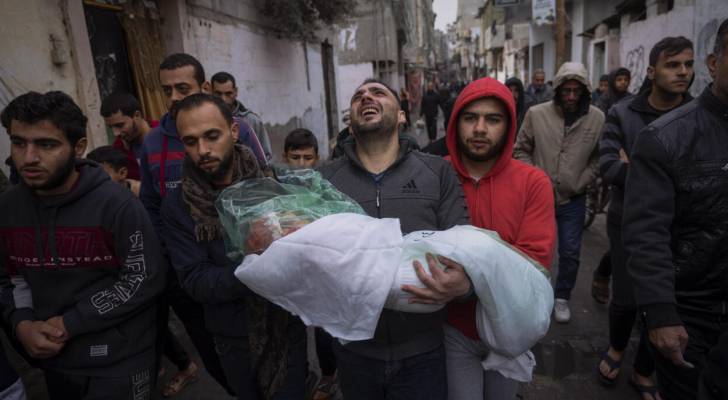600 days of genocide: Gaza’s unfolding tragedy
Gaza Strip has endured over 600 days of genocide since October 7, 2023, when 'Israel' began a large-scale military campaign involving airstrikes, ground operations, and a tightened blockade.
This followed the October 7 events, when Hamas fighters broke the siege into Palestinian-occupied territories.
As of May 28, 2025, the genocide continues, with significant tolls on life, infrastructure, and humanitarian conditions.
Human toll: Deaths, injuries
According to figures from the Gaza Ministry of Health, more than 54,000 Palestinians have been killed. This represents roughly 1 in every 44 residents of Gaza’s pre-war population of 2.3 million. Approximately 70 percent of the deceased are women and children, including an estimated 18,000 children—1,300 of whom were under the age of two.
In addition, over 110,265 people have been injured. The World Health Organization (WHO) reports that nearly 22,500 of these individuals require rehabilitation for severe injuries, particularly amputations. By the end of 2024, 4,500 amputations had been recorded. UNRWA reported that 10 children are losing one or both legs each day, many undergoing procedures without anesthesia due to shortages.
An estimated 10,000 people are missing, presumed buried beneath rubble. A July 2024 analysis published in The Lancet projected that indirect deaths caused by starvation, disease, and lack of medical care could increase the total death toll to as high as 186,000.
Humanitarian crisis: Starvation, disease
'Israel’s' blockade, in place since 2007 and intensified after October 2023, has severely restricted humanitarian access. By September 2024, around 500,000 Palestinians were experiencing extreme levels of hunger. Acute malnutrition affected over 21,600 children aged six months to five years, and at least 34 Palestinians, mainly children, have died from malnutrition.
The blockade has also affected water and sanitation services. The United Nations reported over 995,000 cases of acute respiratory infections, 577,000 cases of acute watery diarrhea, 107,000 cases of jaundice, and 12,000 cases of bloody diarrhea. Water availability remains at just 1.5 to 1.8 liters per person per day—far below the WHO’s recommended 100 liters.
Infrastructure damage
Destruction of infrastructure across the Gaza Strip is widespread. Satellite imagery indicates up to 160,000 buildings have been damaged or destroyed, including 90,000 housing units completely demolished. About 70 percent of Gaza’s civilian infrastructure has been impacted. This includes:
- 320 schools
- 1,671 industrial facilities
- 183 health facilities (including 23 hospitals and 59 clinics)
- 92 ambulances
- All 12 universities in Gaza have been damaged or destroyed, affecting more than 600,000 students.
Cultural, religious sites
More than 340 mosques, including the historic Great Omari Mosque, have been damaged or destroyed. At least three churches, including St. Porphyrius Church, were also affected. At least 16 cemeteries have been damaged or desecrated, along with over 200 cultural sites such as libraries and museums.
Displacement, detention
Nearly 1.9 million Palestinians—about 80 percent of Gaza’s population—have been displaced. Many are sheltering in overcrowded tents or makeshift shelters. A siege on northern Gaza in October 2024 displaced large numbers and raised concerns about forced population transfers.
'Israeli' forces have detained more than 5,000 Palestinians from Gaza, including hundreds of women and children. At least 160 healthcare workers are also detained, with reports of torture and deaths in custody. Among those who died while detained are doctors Adnan Al-Bursh and Iyad Al Rantisi.
Attacks on aid workers, journalists, and healthcare
At least 274 aid workers, including 197 UNRWA staff, have been killed since the genocide began. Another 539 internally displaced people were killed while sheltering in UN facilities. Over 200 journalists have also been killed, according to UNESCO.
Additionally, 986 medical workers, including 165 doctors and 260 nurses, have died. Medical facilities such as Al-Shifa Hospital and the Nasser Medical Complex have been targeted, drawing criticism from international health organizations.
Legal, international response
In December 2023, South Africa filed a case at the International Court of Justice (ICJ), accusing 'Israel' of genocide. The court issued provisional measures in January 2024 ordering 'Israel' to prevent genocidal acts and preserve evidence. In May 2024, the International Criminal Court (ICC) requested arrest warrants for 'Israeli' Prime Minister Benjamin Netanyahu and former Defense Minister Yoav Gallant for war crimes, including the use of starvation as a method of warfare.
Over 600 days into the genocide, the Gaza Strip faces ongoing devastation. The data shows significant human loss, widespread displacement, and large-scale destruction of infrastructure and cultural heritage. While international legal proceedings continue, the humanitarian situation remains critical, with millions affected by hunger, disease, and lack of shelter.




